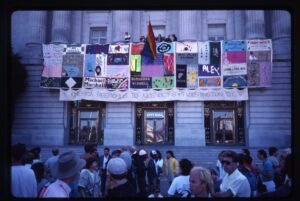Guest high school blogger uses UC Berkeley Oral History Center interviews to write about Social Biases in AIDS Research and Treatment. This is part one of a 3-part series. Resources for teachers are at the end of the article.
Obstacles in AIDS Research and Treatment: Social Biases
by Ella S. Damty
Sophomore, El Cerrito High School
Early responses to the AIDS epidemic across the United States were slowed by biases against—and lack of concern for—the country’s gay communities. Many community leaders didn’t believe that a disease ailing homosexuals would affect their communities, and the methods of transmission (gay sex and IV drug use) made it appear to only affect people who engaged in illegal or, as some considered it, immoral behavior. In addition, the disease heightened stigma against homosexuals with names like gay cancer and GRID (Gay-Related Immune Deficiency), and made the gay community wary of public health officials. These social biases ostracized AIDS victims and made many public officials reluctant to act on their behalf.
One of the ways that public health officials tried to slow the spread of the disease was to spread information about it, with the help of local political leaders. But many of these politicians shrugged it off as something that wasn’t important or wouldn’t affect their communities. Dermatologist Marcus Conant, who first diagnosed Kaposi’s Sarcoma in AIDS patients and was involved in AIDS treatment and research since the epidemic began, recalls a meeting held to distribute pamphlets:
Ernie came to me that night and he said, “You won’t believe this. Most of the people just took it [the pamphlet] and kind of shrugged and walked off. One guy said, ‘Homosexuals?! We don’t have homosexuals where I come from!’” (Conant, 102)

Another obstacle to getting local leaders to take interest in treating the disease was that is was widely viewed as a law enforcement issue, because it was spread through gay sex and intravenous drug use, both of which were illegal activities at the time. As Conant explains it, “If you have this mindset, that this is a law enforcement problem, not a medical problem, then it’s not surprising that from the top all the way down there has been this constant resistance to do anything, to move (129).”
In addition to local leaders’ resistance to act on the issue, gay communities feared that the public health officials would use the disease as an excuse to curb their newfound freedoms. The gay community in San Francisco at the time saw the bathhouses as a symbol of gay liberation in the city. But it was also a hotspot for HIV transmission. Donald Abrams, a gay man treating AIDS, discusses the issue of closing the bathhouses from his perspective as a member of both groups.
But still, as a gay man and as a member of a group of people that had been persecuted from time immemorial, I also thought that in the absence of knowing what AIDS is really caused by and being absolutely certain that closing the bathhouses would have very wide-ranging repercussions, I saw both sides of the issue. The gay community had achieved a lot of liberation and a lot of prominence in San Francisco over the seventies and on into the early eighties, and I thought that closing the bathhouses would really be a political setback. (Abrams 46)
These biases against and from the gay community delayed the response to AIDS in San Francisco and around the country. The view of homosexuals as outsiders and criminals made public officials reluctant to act on their behalf, and made the gay community skeptical of their efforts when they did act.
Photo: The NAMES Project AIDS Memorial Quilt panels displayed at San Francisco City Hall during San Francisco Lesbian and Gay Freedom Day Parade, 1988. (UC San Francisco, Library, Special Collections. Source: Calisphere)
Resources for Teachers
Education resources, including tips for interviewing, tutorial for searching our collection, and the complete Epidemics in History — AIDS/HIV curriculum with sample assignments.
Student project: See the website by Ella S. Damty, based on the class assignment developed by UC Berkeley undergraduate research apprentice Corina Chen: Virus Hunters Newsletter: Obstacles in AIDS Research and Treatment
Seven-episode podcast: First Response: AIDS and Community in San Francisco.
All interviews in the AIDS Epidemic in San Francisco Oral History project.